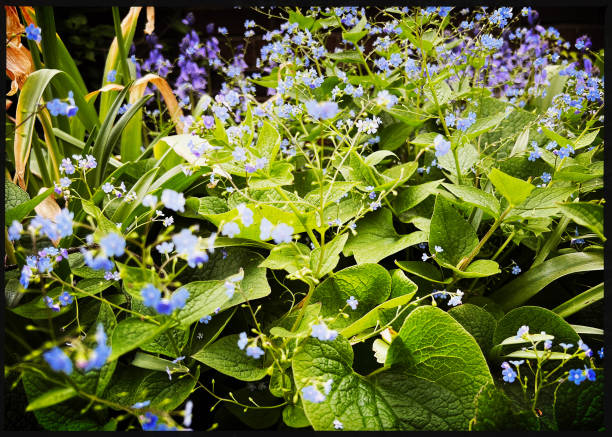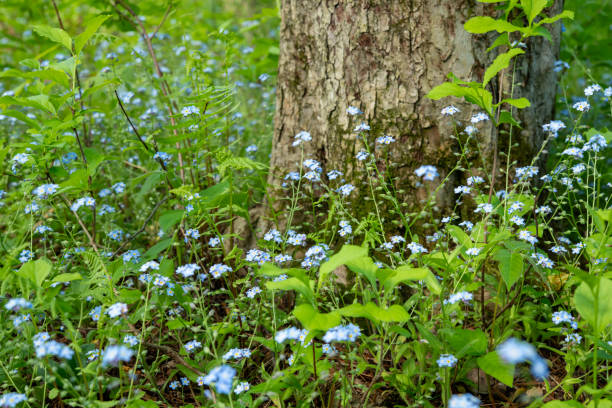Forget-me-nots are charming, tiny blue flowers that can add a delicate touch to any garden. Growing these beauties is relatively simple, and with the right care, they can flourish in a variety of environments. In this article, we will explore the steps needed to grow vibrant forget-me-nots, ensuring that every gardener can enjoy their delightful presence.
Choosing the Right Location

Forget-me-nots thrive best in partially shaded areas. They favor environments where they are shielded from the harsh midday sun but still receive enough light to flower profusely. Ideally, select a spot that offers morning sun and afternoon shade. The soil should be well-draining yet capable of retaining some moisture. Adding organic matter or compost can help improve the soil’s texture and fertility.
Planting Forget-Me-Not Seeds
To begin, sow forget-me-not seeds directly into the soil in early spring. Make shallow furrows about 1/4 inch deep and sprinkle the seeds thinly. Cover them lightly with soil and keep the area moist but not waterlogged. Seeds generally germinate within 1-2 weeks. Ensure that you thin the seedlings to avoid overcrowding, allowing at least 4-6 inches of space between each plant.
Watering and Maintenance
Forget-me-nots prefer consistently moist soil. Water your plants regularly, especially during dry spells. However, it’s crucial to avoid waterlogging, as overly wet conditions can lead to root rot. Mulching around the plants can help retain soil moisture and regulate temperature. Additionally, deadheading spent flowers can encourage more blooms and prevent the plant from self-seeding excessively, which can lead to a messy garden.
Dealing with Pests and Diseases
While forget-me-nots are relatively hardy, they can be susceptible to pests like aphids and diseases such as powdery mildew. Regularly inspect your plants and take action at the first sign of trouble. Here are some tips to keep pests and diseases at bay:
- Use insecticidal soap to treat aphid infestations.
- Keep the area around the plants clean to discourage mildew.
- Water the base of the plants to keep foliage dry and minimize disease risk.
- Consider planting companion plants that repel pests.
Dividing and Propagating
Forget-me-nots are prolific self-seeders, but you can also divide established plants to propagate them. The best time to divide forget-me-nots is in the spring or fall. Carefully dig up a mature plant and gently separate the roots. Replant the divisions immediately, ensuring they are well-watered until established. Dividing plants not only helps you propagate but also rejuvenates overcrowded flower beds.
Conclusion
Growing forget-me-nots is a rewarding endeavor that can add a touch of timeless beauty to your garden. By choosing the right location, providing consistent care, and managing potential pests and diseases, you can enjoy these charming flowers year after year. Whether used as ground cover or in a woodland garden, forget-me-nots are sure to become a beloved addition to your floral landscape.
FAQs
1. How often should I water my forget-me-nots?
Water forget-me-nots regularly to keep the soil consistently moist but avoid waterlogging. Aim for moderate watering, especially during dry spells.
2. Can forget-me-nots grow in full sun?
While forget-me-nots prefer partially shaded areas, they can tolerate full sun if the soil remains moist. However, they may show signs of stress and require more frequent watering.
3. When is the best time to plant forget-me-not seeds?
The best time to plant forget-me-not seeds is in early spring. This timing allows seedlings to establish before the warmest months.
4. How do I prevent forget-me-nots from self-seeding excessively?
Deadheading spent flowers can prevent forget-me-nots from self-seeding excessively. Regularly removing old blooms redirects the plant’s energy into producing new flowers instead of seeds.
5. What types of soil are best for forget-me-nots?
Forget-me-nots thrive in well-draining, moist soil. Adding organic matter or compost can enhance soil texture and fertility, providing an ideal growing environment for these delicate flowers.
